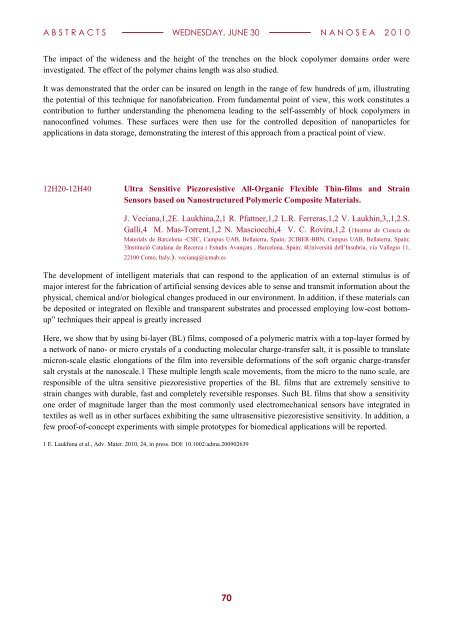book of abstracts - IM2NP
book of abstracts - IM2NP
book of abstracts - IM2NP
Create successful ePaper yourself
Turn your PDF publications into a flip-book with our unique Google optimized e-Paper software.
A B S T R A C T S WEDNESDAY, JUNE 30 N A N O S E A 2 0 1 0<br />
The impact <strong>of</strong> the wideness and the height <strong>of</strong> the trenches on the block copolymer domains order were<br />
investigated. The effect <strong>of</strong> the polymer chains length was also studied.<br />
It was demonstrated that the order can be insured on length in the range <strong>of</strong> few hundreds <strong>of</strong> µm, illustrating<br />
the potential <strong>of</strong> this technique for nan<strong>of</strong>abrication. From fundamental point <strong>of</strong> view, this work constitutes a<br />
contribution to further understanding the phenomena leading to the self-assembly <strong>of</strong> block copolymers in<br />
nanoconfined volumes. These surfaces were then use for the controlled deposition <strong>of</strong> nanoparticles for<br />
applications in data storage, demonstrating the interest <strong>of</strong> this approach from a practical point <strong>of</strong> view.<br />
12H20-12H40<br />
Ultra Sensitive Piezoresistive All-Organic Flexible Thin-films and Strain<br />
Sensors based on Nanostructured Polymeric Composite Materials.<br />
J. Veciana,1,2E. Laukhina,2,1 R. Pfattner,1,2 L.R. Ferreras,1,2 V. Laukhin,3,,1,2.S.<br />
Galli,4 M. Mas-Torrent,1,2 N. Masciocchi,4 V. C. Rovira,1,2 (1Institut de Ciencia de<br />
Materials de Barcelona -CSIC, Campus UAB, Bellaterra, Spain; 2CIBER-BBN, Campus UAB, Bellaterra, Spain;<br />
3Institució Catalana de Recerca i Estudis Avançats , Barcelona, Spain; 4Universitá dell‟Insubria, via Vallegio 11,<br />
22100 Como, Italy.). vecianaj@icmab.es<br />
The development <strong>of</strong> intelligent materials that can respond to the application <strong>of</strong> an external stimulus is <strong>of</strong><br />
major interest for the fabrication <strong>of</strong> artificial sensing devices able to sense and transmit information about the<br />
physical, chemical and/or biological changes produced in our environment. In addition, if these materials can<br />
be deposited or integrated on flexible and transparent substrates and processed employing low-cost bottomup”<br />
techniques their appeal is greatly increased<br />
Here, we show that by using bi-layer (BL) films, composed <strong>of</strong> a polymeric matrix with a top-layer formed by<br />
a network <strong>of</strong> nano- or micro crystals <strong>of</strong> a conducting molecular charge-transfer salt, it is possible to translate<br />
micron-scale elastic elongations <strong>of</strong> the film into reversible deformations <strong>of</strong> the s<strong>of</strong>t organic charge-transfer<br />
salt crystals at the nanoscale.1 These multiple length scale movements, from the micro to the nano scale, are<br />
responsible <strong>of</strong> the ultra sensitive piezoresistive properties <strong>of</strong> the BL films that are extremely sensitive to<br />
strain changes with durable, fast and completely reversible responses. Such BL films that show a sensitivity<br />
one order <strong>of</strong> magnitude larger than the most commonly used electromechanical sensors have integrated in<br />
textiles as well as in other surfaces exhibiting the same ultrasensitive piezoresistive sensitivity. In addition, a<br />
few pro<strong>of</strong>-<strong>of</strong>-concept experiments with simple prototypes for biomedical applications will be reported.<br />
1 E. Laukhina et al., Adv. Mater. 2010, 24, in press. DOI: 10.1002/adma.200902639<br />
70

















